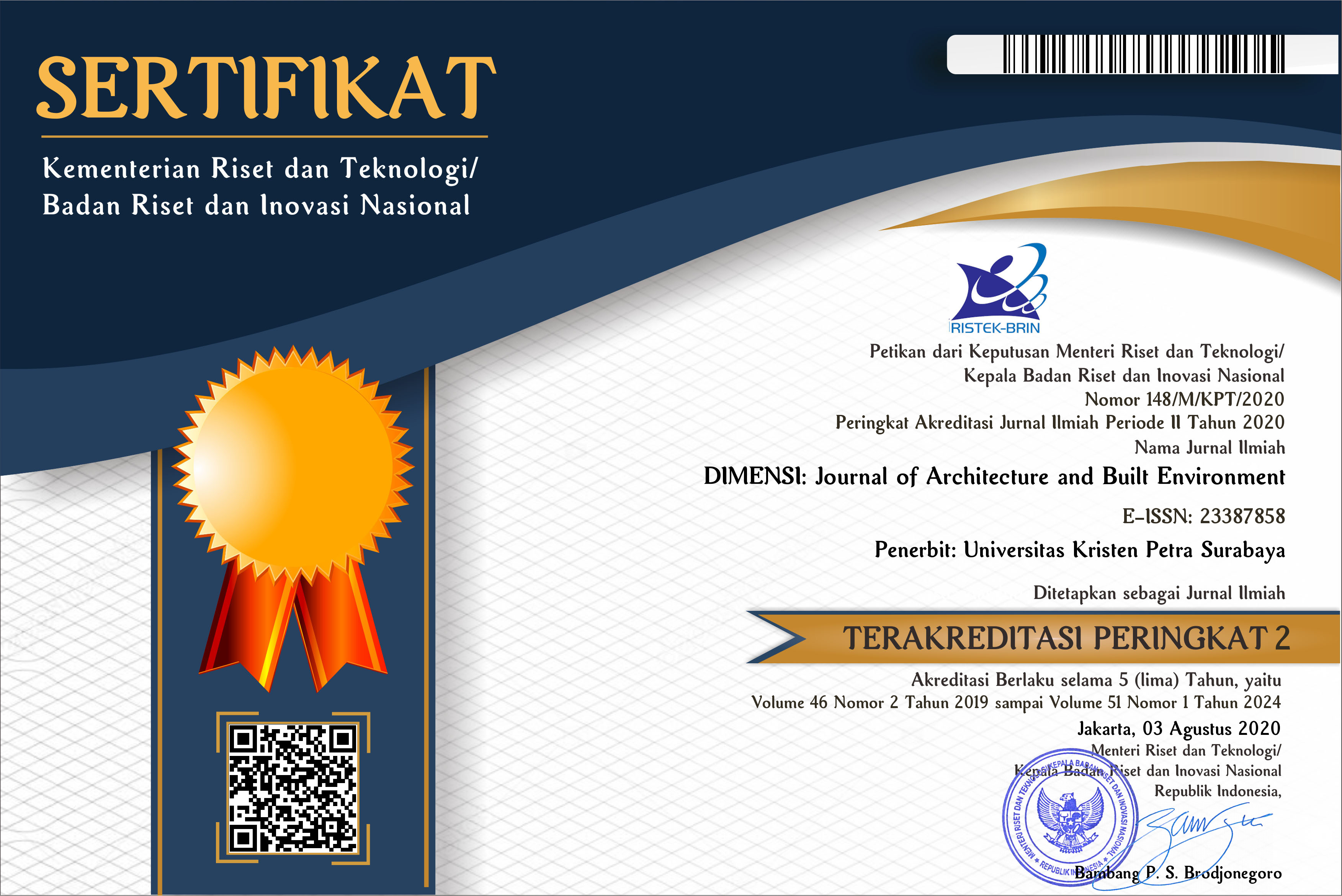URBAN RESILIENCE: HOW TO APPLY IN THE PLANNING AND DESIGN PRACTICE?
 :
:
https://doi.org/10.9744/dimensi.49.1.9-18
Keywords:
Evolutionary resilience, planning theory, resilient cityAbstract
This paper aims to explore the advocacy of how urban resilience should be put into the discourse of planning and design practice, especially the standing of the concept within planning theory. The study is conducted through a literature review with objectives among others: (1) to get the insight of what is urban resilience concept and how it has been used in the context of the urban and regional system? and (2) to elaborate the potential of urban resilience concept be used in the planning and design practice through the perspective of planning theory. The initial result of the study concludes that the urban resilience concept has the potential to reframe the perspective of planning theory that has been applied nowadays particularly the theory of planning and theory in planning with the emergence of so-called transformative and recovery planning.
Downloads
References
Alexander, D. E. (2013). Resilience and disaster risk reduction: An etymological journey. Natural Hazards and Earth System Sciences, 13(11), 2707–2716. https://doi.org/10.5194/nhess-13-2707-2013
Alexander, E. R. (1986). Approaches to planning: Introducing current planning theories, concepts, and issues. Taylor & Francis.
Campanella, T. J. (2006). Urban resilience and the recovery of new orleans. Journal of the American Planning Association, 72(2),141–146. https://doi.org/10.1080/01944360608976734
Carpenter, S. R., Westley, F., & Turner, M. G. (2005). Surrogates for resilience of social-ecological systems. Ecosystems, 8(8), 941–944.
Chelleri, L., & Olazabal, M. (2012). Multidisciplinary perspectives on urban resilience: a workshop report. BC3, Basque Centre for Climate Change.
Cutter, S. L., Burton, C. G., & Emrich, C. T. (2010). Disaster Resilience Indicators for Benchmarking Baseline Conditions. Journal of Homeland Security and Emergency Management, 7(1). https://doi.org/10.2202/1547-7355.1732
Davoudi, S., Shaw, K., Haider, L. J., Quinlan, A. E., Peterson, G. D., Wilkinson, C., Fünfgeld, H., McEvoy, D., & Porter, L. (2012). Resilience: A Bridging Concept or a Dead End? “Reframing” Resilience: Challenges for Planning Theory and Practice Interacting Traps: Resilience Assess¬ment of a Pasture Management System in Northern Afghanistan Urban Resilience: What Does it Mean in Planni. Planning Theory and Practice, 13(2), 299–333. https://doi.org/10.1080/14649357.2012.677124
Desouza, K. C., & Flanery, T. H. (2013). Designing, planning, and managing resilient cities: A conceptual framework. Cities, 35, 89–99. https://doi. org/10.1016/j.cities.2013.06.003
Faludi, A. (1973). A Reader in Planning Theory,. Pergamon Press.
Ferreira, A., Sykes, O., & Batey, P. (2009). Planning Theory or Planning Theories? The Hydra Model and its Implications for Planning Education. Journal for Education in the Built Environment, 4(2), 29–54. https://doi.org/10.11120/jebe.2009.04020029
Folke, C., Colding, J., & Berkes, F. (2003). Synthesis: building resilience and adaptive capacity in social-ecological systems. Navigating Social-Ecological Systems: Building Resilience for Complexity and Change, 9(1), 352–387.
Friedmann, J. (2003). Why do planning theory? Plann¬ing Theory, 2(1), 7–10. https://doi.org/10.1177/1473095203002001002
Friedmann, J. (2011). Insurgencies: Essays in planning theory. Routledge.
Holling, C. S. (1996). Engineering resilience versus ecological resilience. Engineering within Ecological Constraints, 31(1996), 32.
Irajifar, L., Alizadeh, T., & Sipe, N. (2013). Disaster resiliency measurement frameworks State of the art. World Building Congress 2013. http://www.conference.net.au/cibwbc13/papers/cibwbc2013_submission_250.pdf
Jabareen, Y. (2013). Planning the resilient city: Concepts and strategies for coping with climate change and environmental risk. Cities, 31, 220–229. https://doi.org/10.1016/j.cities.2012.05.004
Kinzig, A. P., Ryan, P., Etienne, M., Allison, H., Elmqvist, T., & Walker, B. H. (2006). Resilience and regime shifts: assessing cascading effects. Ecology and Society, 11(1).
Mayunga, J. S. (2009). Measuring the measure: A multi-dimensional scale model to measure community disaster resilience in the US Gulf Coast region. Texas A&M University.
Moraci, F., Errigo, M. F., Fazia, C., Burgio, G., & Foresta, S. (2018). Making less vulnerable cities: Resilience as a new paradigm of smart planning. Sustainability (Switzerland), 10(3), 1–18. https://doi.org/10.3390/su10030755
Scheffer, M. (2009). Critical transitions in nature and society, vol. 16 Princeton. NJ: Princeton Uni-versity Press.[Google Scholar].
Sharifi, A., Chelleri, L., Fox-Lent, C., Grafakos, S., Pathak, M., Olazabal, M., Moloney, S., Yumagulova, L., & Yamagata, Y. (2017). Concep-tualizing dimensions and characteristics of urban resilience: Insights from a co-design process. Sustainability (Switzerland), 9(6), 1–20. https://doi.org/10.3390/su9061032
Sharifi, A., & Yamagata, Y. (2014). Resilient urban planning: Major principles and criteria. Energy Procedia, 61, 1491–1495. https://doi.org/10. 1016/j.egypro.2014.12.154
Sim, T., Wang, D., & Han, Z. (2018). Assessing the disaster resilience of megacities: The case of Hong Kong. Sustainability (Switzerland), 10(4), 1–16. https://doi.org/10.3390/su10041137
UNISDR, U. (2009). UNISDR Terminology on Di-saster Risk Reduction (2009). UNISDR. Retri¬eved September 27, 2012.
UN-HABITAT. (2020). World Cities Report 2020: Unpacking the Value of Sustainable Urbanization. UN-HABITAT. https://doi.org/10.183 56/c41ab67e-en
Wang, L., Xue, X., Zhang, Y., & Luo, X. (2018). Exploring the emerging evolution trends of urban resilience research by scientometric analysis. International Journal of Environmental Research and Public Health, 15(10). https://doi. org/10.3390/ijerph15102181
Wilson, G. A. (2012). Community resilience, globa-lization, and transitional pathways of decision-making. Geoforum, 43(6), 1218–1231. https://doi.org/10.1016/j.geoforum.2012.03.008
Downloads
Published
How to Cite
Issue
Section
License
Authors who publish with this journal agree to the following terms:
- Authors retain copyright and grant the journal right of first publication with the work simultaneously licensed under a Creative Commons Attribution License that allows others to share the work with an acknowledgement of the work's authorship and initial publication in this journal.
- Authors are able to enter into separate, additional contractual arrangements for the non-exclusive distribution of the journal's published version of the work (e.g., post it to an institutional repository or publish it in a book), with an acknowledgement of its initial publication in this journal.
- Authors are permitted and encouraged to post their work online (e.g., in institutional repositories or on their website) prior to and during the submission process, as it can lead to productive exchanges, as well as earlier and greater citation of published work (See The Effect of Open Access).



















